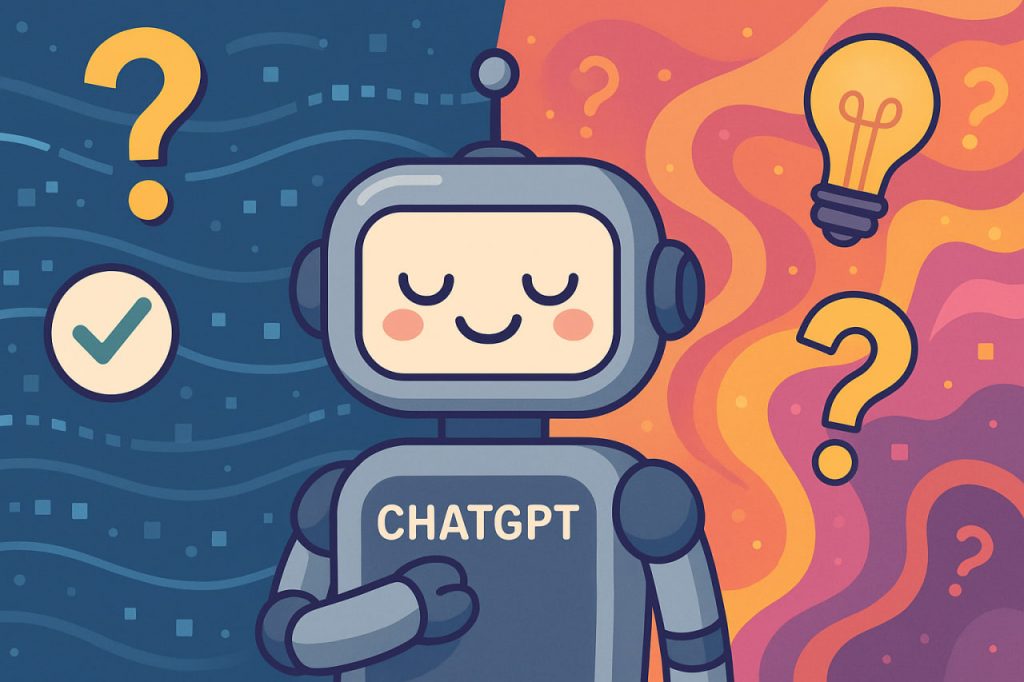Artificial intelligence has transformed how humans interact with information, making tools like ChatGPT seem almost like digital experts. However, one of the most controversial aspects of AI language models is their tendency to produce confident but incorrect answers, a phenomenon researchers call “hallucination.” Instead of admitting uncertainty, the AI sometimes fills gaps with plausible but unverified statements. This behavior raises important questions about how AI “thinks,” how it is trained, and how humans should interpret its responses.
How ChatGPT and Similar Models Work
AI language models like ChatGPT are not conscious beings—they don’t possess beliefs, understanding, or awareness. They are statistical systems trained on enormous datasets containing text from books, articles, and the internet. During training, the model learns patterns in language and predicts the next most likely word in a sentence. Because its goal is to generate coherent, contextually fitting text—not to confirm factual accuracy—it may produce responses that sound convincing even when they’re false. This distinction between linguistic fluency and factual accuracy is the root of why AI sometimes “makes things up.”
The Nature of AI “Hallucinations”
When AI “hallucinates,” it generates content that looks logical but lacks grounding in verified data. For example, if asked about a non-existent study or fictional event, ChatGPT might create one based on similar patterns it has seen. This doesn’t happen because the AI is deceitful, but because it statistically infers what an answer should look like based on its training. According to researchers at OpenAI and other institutions, hallucination is one of the hardest problems in AI language modeling because it arises naturally from how these systems are built.
Why AI Doesn’t Always Admit Uncertainty
Unlike humans, AI models don’t “know what they don’t know.” They lack an internal sense of confidence or ignorance. When asked a question, the model must output something—silence or refusal is not its natural state unless explicitly instructed. While developers train AI to include phrases like “I’m not sure” or “There’s limited information,” the system’s statistical nature pushes it to produce answers that fit patterns of human certainty. Moreover, users often prefer confident-sounding answers, so models are optimized to be helpful and fluent rather than cautious.
Expert Perspectives on AI Accuracy
Experts in artificial intelligence and ethics hold varying opinions on how to address this problem. Dr. Emily Bender, a linguist and AI critic, argues that language models should never be treated as sources of truth because they “predict text, not knowledge.” Meanwhile, Dr. Sam Altman, CEO of OpenAI, has emphasized ongoing efforts to improve factual reliability by integrating retrieval systems that cross-check information in real time. Other researchers suggest that hybrid systems—combining AI’s linguistic power with verified databases—can reduce errors and prevent misinformation from spreading.
The Human Role in AI Communication
One of the most important lessons in using AI responsibly is recognizing that it should serve as a tool, not an authority. Human oversight is essential for fact-checking and contextual interpretation. Teachers, journalists, and scientists use ChatGPT to generate ideas, summaries, or translations—but not as a final source. Critical thinking, skepticism, and verification remain irreplaceable human skills. As AI continues to evolve, collaboration between humans and machines becomes a partnership rather than dependence.
The Efforts to Make AI More Truthful
Developers are actively addressing the problem of AI hallucinations. Techniques such as reinforcement learning from human feedback (RLHF) help train models to prioritize factual accuracy. Other improvements include retrieval-augmented generation (RAG), which allows the AI to access up-to-date databases during responses. Additionally, transparency labeling helps users identify whether the AI is reasoning, citing sources, or speculating. The ultimate goal is to create systems that communicate uncertainty naturally and differentiate between verified facts and creative inference.
Ethical Considerations and User Responsibility
Ethicists warn that the danger of AI-generated misinformation lies not just in the machine’s design but in how people use it. Overtrusting AI responses can lead to the spread of falsehoods in education, politics, or healthcare. Dr. Margaret Mitchell, co-founder of Google’s Ethical AI team, stresses that developers and users share moral responsibility: developers must design honest systems, and users must treat AI answers critically. Transparency, disclosure of limitations, and education on digital literacy are vital steps toward ethical AI use.
Interesting Facts
- The term “AI hallucination” was first popularized by researchers at Google Brain in 2018.
- ChatGPT doesn’t have internet access by default—it generates answers based on pre-trained data patterns.
- Some AI models can estimate their own confidence levels, but this remains an experimental feature.
- Human feedback during model training has significantly reduced factual errors compared to earlier AI systems.
- OpenAI, Anthropic, and Google are investing heavily in truth verification frameworks for future AI systems.
Glossary
- Hallucination (AI) – The generation of false or misleading information by an AI model that appears credible.
- Reinforcement Learning from Human Feedback (RLHF) – A training method that improves AI behavior using human evaluation.
- Retrieval-Augmented Generation (RAG) – A system where AI retrieves real information from databases before generating text.
- Transparency Labeling – Marking AI responses to indicate confidence or source verification.
- Statistical Modeling – The mathematical process of predicting outcomes (like words) based on patterns in data.
- Confidence Calibration – The ability of an AI to estimate how certain it is about its own responses.
- Misinformation – False or inaccurate information, whether spread intentionally or not.
- Ethical AI – Artificial intelligence designed with fairness, accuracy, and accountability in mind.
- Digital Literacy – The skill of critically evaluating information and technology use.
- Bias – Systematic error in AI responses caused by imbalanced or skewed training data.


